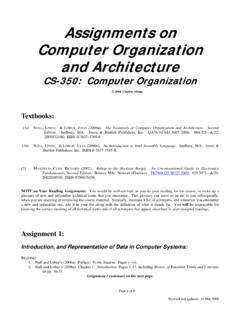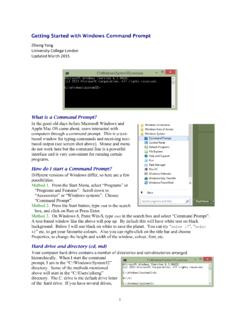Transcription of Microsoft’s Disk Operating System
1 microsoft s disk Operating System CS-550-1: Operating Systems Fall 2003 Dominic Swayne Table of Contents An Overview:..1 History and design Success by Easy to translate Speed and efficiency Written in Assembly Language Advancing the The Structures of Internal Structure of The Basic Input/Output System (BIOS)..2 The DOS The Command Resident and transient ..3 Memory The System Interrupt DOS High Expanded Discrimination and behavior characteristics by program Dynamic Recognized native file Memory Processor Modes and Real Protected 1 An Overview: History and design environment.
2 microsoft s disk Operating System (MS-DOS) was one of several Operating systems developed in the early 1980s to support the commercial release of 16-bit personal computers. The purpose of this paper is to explore microsoft s disk Operating System , describe some of the important aspects of the software, and develop a better understanding of the software. First known as 86-DOS, it was developed in about 6 weeks by Tim Paterson of Seattle Computer Products (SCP). The OS was designed to operate on the company s own 16-bit personal computers running the Intel 8086 microprocessor.
3 (Paterson, 1983a) When 86-DOS was developed, Digital Research s Control Program for Microcomputers (CP/M-80) was the Operating System most commonly in use for 8-bit personal computers. (Flynn, McHoes, 1996) CP/M-80 was supported by a wide range of application software. Although developed for the new 16-bit environment of the PC, Paterson designed 86-DOS so that it was very similar to the 8-bit CP/M-80. Using translation rules published by Intel, it was relatively easy to port existing application programs to 86-DOS. International Business Machines (IBM) was working on the hardware design for their entrance to the personal computer market using Intel s 8086 processor.
4 Searching for an Operating System to support their new product, IBM sought proposals from two of the leading OS software companies at the time: Digital Research and Softech. (Flynn, McHoes, 1996) Wanting to compete but lacking an Operating System of their own, microsoft worked out a licensing deal with SCP, allowing microsoft to market 86-DOS under the microsoft name paying a royalty fee to SCP. In July of 1981, microsoft purchased the rights to 86-DOS, renaming it MS-DOS. Later that year IBM released its first PC with MS-DOS (called PC-DOS on the IBM machines) as its primary Operating System .
5 (UNESCO, 1999) Success by Design Paterson designed the Operating System with three specific goals. First, make it easy to translate existing applications designed for the CP/M-80 Operating System and running on the Z80 8-bit processor into applications that would run in 86-DOS on the 8086 16-bit processor. Designing 86-DOS so that existing applications could easily be ported to it was very significant to its commercial viability. However, what ultimately secured the commercial viability of MS-DOS was IBM s release of its first Personal Computer in the fall of 1981 shipping them with MS-DOS as the primary Original Equipment from the Manufacturer (OEM) Operating System .
6 (Paterson, 1983a) The second design goal is typical of most modern Operating systems; speed and efficiency. Paterson designed 86-DOS so that the maximum System memory would be available to applications, minimized disk transfers, improved the speed of disk transfers, and decreased OS compute time. (Paterson, 1983a) The final design goal was that the OS be written in assembly language. This was a practical matter rather than a philosophical decision. According to Paterson, The only software 2 development tools available to Seattle Computer at the time were an assembler that ran on the Z80 under CP/M and a monitor/debugger that fit into a 2K-byte EPROM (erasable programmable read-only memory).
7 Both these tools had been developed in house. (Paterson, 1983a) The first version of DOS used by IBM was written in 4000 lines of assembly-language source code and required 8k of memory. (Stallings, 1995) From its start as Version in 1981, MS-DOS underwent significant revisions until it was ultimately retired as a separate product line in 1994 with the introduction of Windows 95 (though Windows still ran on top of DOS for several more versions of Windows). In 1989, DOS accounted for 61 percent of the PC Operating systems shipped worldwide and had an installed base of over 45 million.
8 DOS was running more personal computers than all other Operating systems combined. (Duncan et al., 1990) Advancing the state-of-the-art. Though it was not elegant and didn t employ any revolutionary new concepts, microsoft s disk Operating System advanced the adoption of technology in many ways. MS-DOS was the first large-scale commercial Operating System that functioned on the new 16-bit Personal Computer hardware (Intel s 8086 processor). It was the first general purpose Operating System designed to run on multiple hardware configurations of the personal computer (running Intel's x86 family of processors).
9 Finally, largely due to IBM s endorsement, MS-DOS created an industry standard for general-purpose Operating systems. (Flynn, McHoes, 1996) Limitations. By design, DOS is a simple Operating System with backwards compatibility. Therein lies one of its greatest weakness. DOS manages jobs from a single user, sequentially on a single processor. The original version could address a maximum of 1MB of memory, user programs were limited to 640k, and it did not support hard drives. Although its layered design, covered in detail later, permitted DOS to grow beyond these initial limitations, it remained a 16-bit Operating System even though 32-bit hardware and the ability to change processor modes on the fly (see EMS page 4) became widely available with the introduction of the Intel 386 processor.
10 The Structures of MS-DOS Internal Structure of DOS. Designed in layers, the Operating System has three essential components: the BIOS module, the kernel, and the command processor. The Basic Input/Output System (BIOS) is specific to each hardware System and is provided by the hardware manufacturer. The BIOS contains drivers for the basic hardware: the display, keyboard, line printer, clocks, and boot device, and is normally supplied by the hardware manufacturer. The most primitive components of the BIOS, called the resident portion, is stored in Read Only Memory (ROM) and loaded into main memory when the System is initialized.













